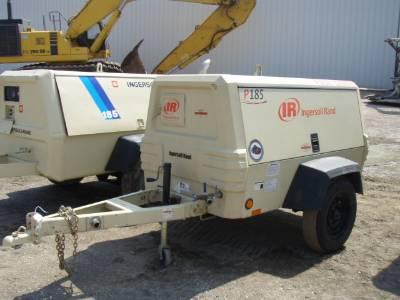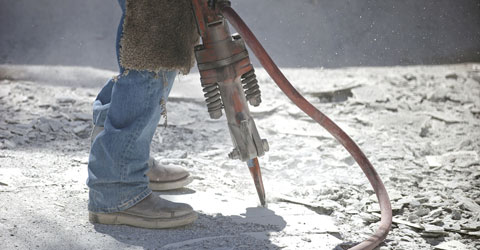Compressed air plant
Contents |
[edit] Introduction
There are a wide range of tools and plant on construction sites that use compressed air as their power source. The advantage that this equipment has is that the power source is very mobile and so they can be easily handled, which can be beneficial on isolated sites or in confined spaces.
The type of plant will depend on the nature of the work involved. The type of compressed air system can be either:
- Local: The compressor unit, with air-receiving tank, is mounted on a mobile unit for moving around the site.
- Centralised: A larger, semi-permanent compressor house is built to accommodate the plant and a network of air pipes taken to various outlet points.
[edit] Air compressors
The two main types of compressor are the reciprocating or piston type and the rotary impeller type.
[edit] Reciprocating compressor
This can be either single stage or multi-stage:
- Single stage: Air is drawn into the cylinder and a piston compresses it in one stroke.
- Multi-stage: Air passes through a series of cylinders, each of which contains air at increasing pressures.
Multi-stage compressors have the advantage of giving greater efficiency, and are suitable for high pressures and high volumes of air. This makes them useful for centralised plant, as the amount of compressed air can be as much as 130 m3 per minute.
[edit] Rotary compressor
These consist of a high-speed rotor mounted in a cylinder. Air is drawn in from an intake port by centrifugal force and exits through the delivery port when the required pressure has been achieved. Air receivers store the compressed air as it leaves the high pressure cylinder and minimise pressure fluctuations.
[edit] Tools and equipment
The four basic types of tools are:
[edit] Percussion type tools
- Concrete breakers (jack hammer): These are used for breaking up road surfaces. They consume air at a rate of 10-20 m3/min, and typically weigh 15-40 kg. They are flexible in terms of being able to be fitted with a variety of heads for different requirements.
- Pneumatic picks: Similar to concrete breakers but smaller and lighter. Typically they have an air consumption rate of around 6 m3/min.
- Backfill rammers: Used for backfilling trenches and have a consumption rate of around 10 m3/min.
- Chipping, caulking, riveting hammers: Small, lightweight tools with low air consumption of around 0.5 m3/min.
[edit] Pneumatic tools (with rotary action)
- Hammer drills: Used for wet or dry drilling, and commonly used for drilling rock or concrete. A rotary motion is generated by the piston, which produces the hammer action. Typically they have an air consumption rate of 5-10 m3/min.
- Rock drills: Larger and heavier than hammer drills, they are and commonly used for tunneling and quarry drilling. Their weight often necessitates the use of a frame support. They have an air consumption rate of around 15-24 m3/min.
[edit] Rotary type tools
These are powered by air motors with rotary sliding vanes. Common examples include; chainsaws, circular saws and wood-boring machines.
[edit] Miscellaneous tools
- Concrete vibrators.
- Concrete-placing and spraying equipment.
- Jacket-type silencers (these are often used as a means of dampening the noise created by compressed air equipment).
- Paint-spraying equipment.
- Pile-driving equipment.
- Road compactors.
- Sump pumps.
[edit] Related articles on Designing Buildings Wiki
- Bituminous mixing and laying plant.
- Breaker.
- BSRIA Compressor Study September 2020 - The Americas and China
- Cherry pickers.
- Concreting plant.
- Construction plant.
- Construction tools.
- Crane supports.
- Earth-moving plant.
- Equipment in buildings.
- EMEA compressor market 2020 - 2023.
- Excavating plant.
- Forklift truck.
- Hand-arm vibration syndrome.
- Hoist.
- Lift table.
- Pallet jack.
- Power float.
- Pumps and dewatering equipment.
- Road sweeper.
- Scabbler.
- Scaffolding.
- Six remarkable benefits of high pressure water jetting.
- Types of crane.
[edit] External references
- ‘Introduction to Civil Engineering Construction’ (3rd ed.), HOLMES, R., The College of Estate Management, (1995)
Featured articles and news
Infrastructure that connect the physical and digital domains.
Harnessing robotics and AI in challenging environments
The key to nuclear decommissioning and fusion engineering.
BSRIA announces Lisa Ashworth as new CEO
Tasked with furthering BSRIA’s impressive growth ambitions.
Public buildings get half a million energy efficiency boost
£557 million to switch to cleaner heating and save on energy.
CIOB launches pre-election manifesto
Outlining potential future policies for the next government.
Grenfell Tower Inquiry announcement
Phase 2 hearings come to a close and the final report due in September.
Progress from Parts L, F and O: A whitepaper, one year on.
A replicated study to understand the opinion of practitioners.
ECA announces new president 2024
Electrical engineer and business leader Stuart Smith.
A distinct type of countryside that should be celebrated.
Should Part O be extended to existing buildings?
EAC brands heatwave adaptation a missed opportunity.
Definition of Statutory in workplace and facilities management
Established by IWFM, BESA, CIBSE and BSRIA.
Tackling the transition from traditional heating systems
59% lack the necessary information and confidence to switch.
The general election and the construction industry
As PM, Rishi Sunak announces July 4 date for an election.
Eco apprenticeships continue help grow green workforce
A year after being recognised at the King's coronation.
Permitted development rights for agricultural buildings
The changes coming into effect as of May 21, 2024.
























